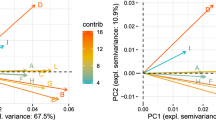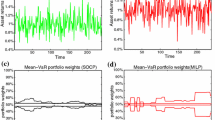Abstract
Portfolios constructed by the classical mean-variance model are very sensitive to outliers. We propose the use of a non-parametric estimation method based on statistical data depth functions. Specifically, we exploit the notion of the weighted \(L^{p}\) depth function to obtain robust estimates of the mean and covariance matrix of the asset returns. This approach has the advantage to be independent of parametric assumptions, and less sensitive to changes in the asset return distribution than traditional techniques. The proposed procedure is evaluated and compared with standard and other robust techniques through simulated and real data. Results indicate effective improvements of the proposed method in terms of out-of-sample performance.


Similar content being viewed by others
References
Ceria, S., & Stubbs, R. A. (2006). Incorporating estimation errors into portfolio selection: Robust portfolio construction. Journal of Asset Management, 7(2), 109–127.
Chopra, V. K., & Ziemba, W. T. (1993). The effect of errors in means, variances, and covariances on optimal portfolio choice. The Journal of Portfolio Management, 19(2), 6–11.
DeMiguel, V., & Nogales, F. J. (2009). Portfolio selection with robust estimation. Operations Research, 57(3), 560–577.
Donoho, D. L., & Gasko, M. (1992). Breakdown properties of location estimates based on halfspace depth and projected outlyingness. The Annals of Statistics, 20, 1803–1827.
Efron, B., & Tibshirani, R. J. (1994). An introduction to the bootstrap. Boca Raton: CRC Press.
Gervini, D. (2010). Outlier detection and trimmed estimation for general functional data. Statistica Sinica, 22, 1639–1660.
Goldfarb, D., & Iyengar, G. (2003). Robust portfolio selection problems. Mathematics of operations research, 28(1), 1–38.
Hampel, F. (1968). Contributions to the theory of robust estimation. Berkeley: University of California.
Kaszuba, B. (2012). Empirical comparison of robust portfolios’ investment effects. The Review of Finance and Banking, 5(2013), 47–61.
Kim, J. H., Kim, W. C., Kwon, D.-G., & Fabozzi, F. J. (2018). Robust equity portfolio performance. Annals of Operations Research, 266(1), 293–312.
Kosiorowski, D., & Zawadzki, Z. (2015). Locality, robustness and interactions in simple cooperative dynamic game. In Proceedings from 15th International Conference on Group Decissions and Negotiation (pp. 185–188).
Liu, R. Y. (1990). On a notion of data depth based on random simplices. The Annals of Statistics, 18(1), 405–414.
López-Pintado, S., & Romo, J. (2009). On the concept of depth for functional data. Journal of the American Statistical Association, 104(486), 718–734.
Markowitz, H. (1952). Portfolio selection. The Journal of Finance, 7(1), 77–91.
Martin, R. D., Clark, A., & Green, C. G. (2010). Robust portfolio construction. In J. B. Guerard (Ed.), Handbook of portfolio construction (pp. 337–380). Boston: Springer.
Paç, A. B., & Pınar, M. Ç. (2018). On robust portfolio and naïve diversification: Mixing ambiguous and unambiguous assets. Annals of Operations Research, 266(1), 223–253.
Pandolfo, G., Paindaveine, D., & Porzio, G. C. (2018). Distance-based depths for directional data. Canadian Journal of Statistics, 46(4), 593–609.
Perret-Gentil, C., & Victoria-Feser, M.-P. (2005). Robust mean-variance portfolio selection. Available at SSRN 721509.
Rocke, D. M. (1996). Robustness properties of S-estimators of multivariate location and shape in high dimension. The Annals of statistics, 24, 1327–1345.
Scutellà, M. G., & Recchia, R. (2013). Robust portfolio asset allocation and risk measures. Annals of Operations Research, 204(1), 145–169.
Serfling, R. (2006). Depth functions in nonparametric multivariate inference. DIMACS Series in Discrete Mathematics and Theoretical Computer Science, 72, 1–16.
Supandi, E. D., Rosadi, D., et al. (2017). An empirical comparison between robust estimation and robust optimization to mean-variance portfolio. Journal of Modern Applied Statistical Methods, 16(1), 32.
Toma, A., & Leoni-Aubin, S. (2015). Robust portfolio optimization using pseudodistances. PLoS ONE, 10(10), 1–26.
Tsay, R. S. (2005). Analysis of financial time series. Hoboken: Wiley.
Tukey, J. (1975). Mathematics and the picturing of data. Proceedings of the International Congress of Mathematicians, 2, 523–531.
Van Aelst, S., & Rousseeuw, P. (2009). Minimum volume ellipsoid. Wiley Interdisciplinary Reviews: Computational Statistics, 1(1), 71–82.
Victoria-Feser, M.-P. (2000). Robust portfolio selection. Available at SSRN 1763322.
Welsch, R. E., & Zhou, X. (2007). Application of robust statistics to asset allocation models. REVSTAT-Statistical Journal, 5(1), 97–114.
Zuo, Y., Cui, H., et al. (2005). Depth weighted scatter estimators. The Annals of Statistics, 33(1), 381–413.
Zuo, Y., Cui, H., He, X., et al. (2004). On the Stahel-Donoho estimator and depth-weighted means of multivariate data. The Annals of Statistics, 32(1), 167–188.
Zuo, Y., Cui, H., & Young, D. (2004). Influence function and maximum bias of projection depth based estimators. The Annals of Statistics, 32, 189–218.
Zuo, Y., & Serfling, R. (2000). General notions of statistical depth function. The Annals of Statistics, 28(2), 461–482.
Zuo, Y., & Serfling, R. (2004). Robustness of weighted \(L^{p}\)-depth and \(L^{p}\)-median. Allgemeines Statistisches Archiv, 88(2), 215–234.
Acknowledgements
We gratefully acknowledges Valerio Sullo, senior quantitative portfolio manager at Amundi, for gently providing the DAX30 data.
Author information
Authors and Affiliations
Corresponding author
Additional information
Publisher's Note
Springer Nature remains neutral with regard to jurisdictional claims in published maps and institutional affiliations.
Rights and permissions
About this article
Cite this article
Pandolfo, G., Iorio, C., Siciliano, R. et al. Robust mean-variance portfolio through the weighted \(L^{p}\) depth function. Ann Oper Res 292, 519–531 (2020). https://doi.org/10.1007/s10479-019-03474-x
Published:
Issue Date:
DOI: https://doi.org/10.1007/s10479-019-03474-x




